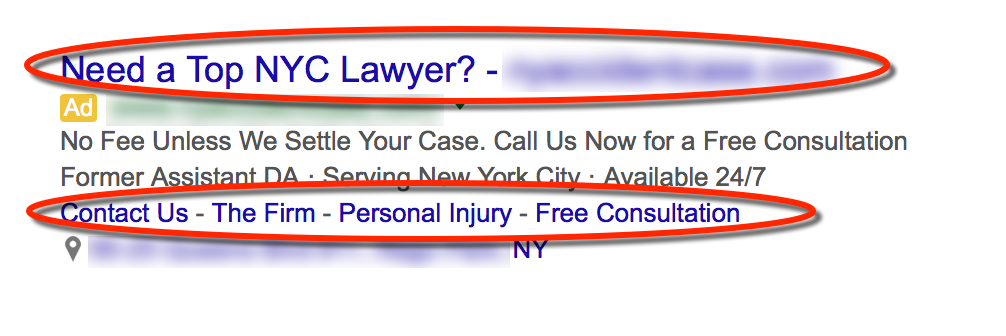In some respects, running a PPC campaign is like cleaning your house. You have day-to-day activities (like emptying the dishwasher, folding laundry). But then you have smaller jobs that are easy to ignore but still need to get done occasionally (dusting lighting fixtures, anyone?).
The same is true of PPC campaigns. Some days, we can hardly keep up with the day-to-day stuff (like checking click-through rates and testing and analyzing keyword match type performance). But still, we have to make time for smaller tasks. And there’s no better time to tackle these tasks than as part of an end-of-year clean up.
So grab your duster and let’s get started:

1. Analyze Your Sitelinks
Sitelinks are URL links that display with your ad. You can set sitelinks to link to your campaign ad landing page and other pages on your website. And they can display in a couple different ways (we’ve circled some sitelinks below):


As you can see, sitelinks make up a large piece of ad real estate, and they play a big part in overall ad performance.
As part of your day-to-day activities, you’re probably already looking at sitelinks as a group, but it’s easy to forget to look at individual sitelink performance too. You can do this by logging into AdWords and clicking the ad extensions tab. From there, click view and choose the type of extension you want to view from the drop-down menu. (For more guidance, see the AdWords help file.)
Once you have performance statistics, all you have to do is rotate out the lowest performing sitelink and test something different.
2. Take Control of Your Snippet Extensions
Snippet extensions are those bits of text that Google inserts into your ad: 
When Google first rolled out this feature, it would pull text off your website and automatically insert it into your ads—with sometimes less than desirable results. (See my article “Where’s the Value in AdWords Dynamic Structured Snippets?” for more on this.)
For example, it’s not uncommon for Google to grab the navigation off your site and use that for the snippet. If it grabs “Services: Bankruptcy, Divorce, Criminal Law, Personal Injury” then that’s not so bad. But if it grabs “Pricing, Features, Contact Us” then that’s not so great. The point is, when you don’t control what gets displayed, odds are that it will either work against you or waste a good opportunity.
Then, with the roll out of structured snippets, Google changed the feature so you can now specify what text gets inserted. But here’s the catch: If you don’t enter the text yourself, Google will still do it for you.
So as part of your year-end clean up, make sure you’ve manually entered the snippet text at the account, campaign or ad group level. (It’s also a great time to rethink your PPC ad extensions more generally, if you haven’t already done so.)
3. Review Search Partner Statistics
Google search partners are sites that partner with Google to extend the reach of ads. Search partners can include Google sites (such as YouTube, Google Maps) and non-Google sites (such as AOL).
So the question becomes, do you WANT to extend the reach of your ads to include these sites? And the only way to answer that question is to try it and see what happens.
It’s easy to include search partners in your campaigns. (“Include search partners” is automatically selected when you create your campaigns.) It’s harder to remember to check back and see how your ads are faring on the search partner sites over time.
To do it, simply compare CPA (cost per acquisition) for search partner site ads to the CPA for Google Search Network ads. If the CPA is significantly higher for the search partner sites, then you might want to deselect this option.
Usually, when we see a higher CPA for search partner sites, we’ll dig further to see if this is a blip or longer standing issue. If we’re uncertain, we may leave things as they are but then check back again until we have enough data to keep or omit.
None of these clean up items is big enough to sink or save a campaign on its own. But in the competitive world of PPC advertising, every little advantage counts. So set aside time before the end of the year to tackle these three items. You’ll start the New Year with campaigns that are cleaned, polished and ready to work!






